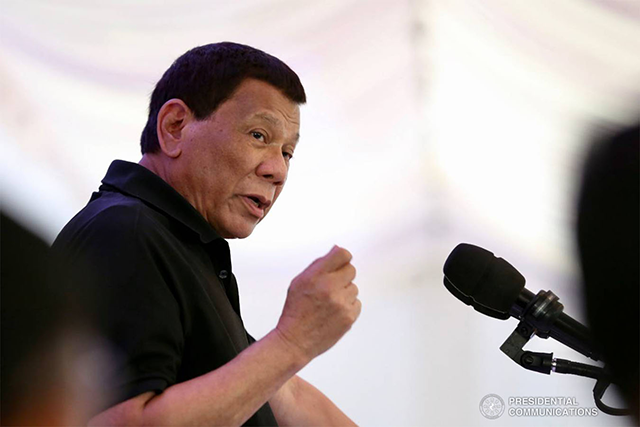Contradicting Surveys: Media Must Explain

President Rodrigo Duterte | Photo from the Presidential Communications Operations Office website
MUCH HAS been said about how polarized Filipinos are on political issues under the Duterte administration. Surveys should help us understand how different opinions and views make up the whole truth in terms of the public’s approval of or satisfaction or trust in their officials.
In reporting survey results, media must go beyond just reporting the numbers and explain the point of surveys and what their findings mean.
According to the second quarter survey of the Social Weather Stations (SWS) released on July 10, President Rodrigo Duterte’s net satisfaction rating dropped to +45 (good) from his March score of +56 (very good). Conducted from June 27 to 30, the polling firm called the 11-point decline a “new personal low,” surpassing his previous lowest score of +48 (good) in September 2017.
Three days later on July 13, Pulse Asia showed a sharply different picture. In its Ulat ng Bayan poll, President Duterte got an 88% approval rating, an 8-point increase from his March rating and two points higher than his previous best of 86% recorded in September 2016, just three months into his presidency. This survey was conducted from June 15 to 21, earlier than the period of the SWS survey.
In an ambush interview in Clark, Pampanga the same day the SWS findings were released, media reported President Duterte’s reaction, brushing off the results: “I do not care. Make it 15. Wala na ako diyan. It does not interest me at all.”
But the Palace was interested enough in the Pulse Asia numbers, as Presidential Spokesperson Harry Roque noted the positive output, even hailing it as the “people’s continuing vote of confidence” for the president.
The difference in the polls’ outcome raised eyebrows, nonetheless, leaving the public with this crucial question: why the sharp disparity?
Media’s straightforward coverage picked up the SWS and then the Pulse Asia numbers, along with the reactions of some quarters on the respective polls. Fortunately, some media organizations made an effort to explain the contradiction.
CMFR reviewed reports from the main broadsheets Manila Bulletin, Philippine Daily Inquirer and The Philippine Star; free TV news programs 24 Oras (GMA-7), Aksyon (TV5), News Night (CNN Philippines) and TV Patrol (ABS-CBN 2); as well as select news websites from July 10 to 15 2018.
TV Explains
Three TV newscasts on the day Pulse Asia released the results went to the heart of the matter and asked the key question: Why the difference?
On July 13, 24 Oras, News Night and TV Patrol aired reports that sought someone who could explain. All three featured Dr. Ana Maria Tabunda, Pulse Asia’s research director, who acknowledged that their poll was conducted before Duterte’s “stupid God” comment on June 22, a “crucial difference” which Pulse Asia failed to capture during their fieldwork because their period of inquiry ended the day before the remark.
News Night (“Survey: Duterte’s trust, approval ratings up in June”) also sought the views of other experts. Amado Mendoza, professor of political science at the University of the Philippines Diliman, agreed with Tabunda that Duterte’s comment was a crucial factor.
Mendoza also saw the terminologies used by polling firms as part of the reason why surveys seem to have different outcomes. He cited the nuances of the terms “trust rating” (“pagtitiwala”) by Pulse Asia and “satisfaction” (“kuntento ka ba?”) by SWS. The professor also called out some survey questions for being vague and for not allowing respondents to explain the “why” of their response. “Mase-settle sana ang ating mga pagtatanong dito kung itong dalawang survey agencies tinatanong nila kung “bakit,” Mendoza said.
No Excuse
Immediate reports online on July 13 focused mostly on the poll numbers. In addition to the survey results, newspapers on July 14 carried statements by the Palace and criticisms by politicians who questioned the methodology of one or the other polling firm. None of the sources cited were qualified to explain how such a discrepancy can happen.
Print’s obvious disadvantage lay in its later release of the news. But this is hardly an excuse as it should have suggested that their first go-to should have been Pulse Asia and then SWS as well as other knowledgeable sources. Sadly, newspaper journalists used what time they had to get quotes from politicians whose take on the issue is colored by their own political agenda.
A lesson for media in reporting surveys: check the basics points on your own. The difference would have been obvious had they noted the dates when SWS and Pulse Asia conducted their surveys. Right off, anyone reporting the results would have been obliged to review when exactly Duterte uttered his scandalous remark against God. This quick review could have led to different questions that would have been more helpful than just gathering reactions from politicians.
This should not be the end of this story. It should serve as a reference to the next cycle of surveys. The higher rankings for the president found by Pulse Asia deserves more discussion.
Leave a Reply